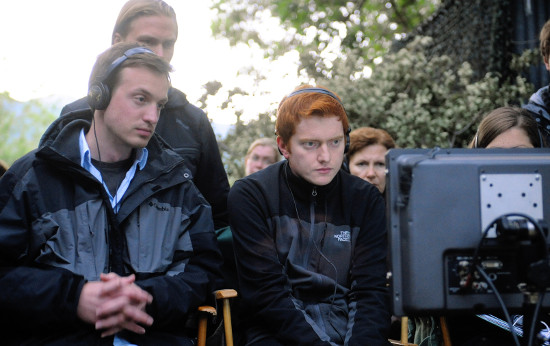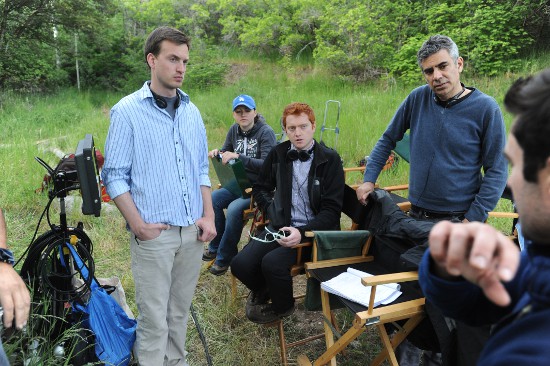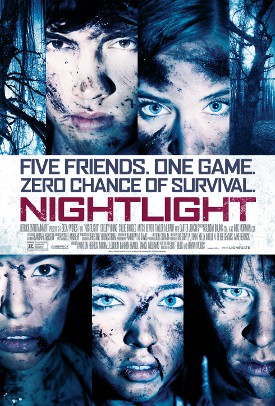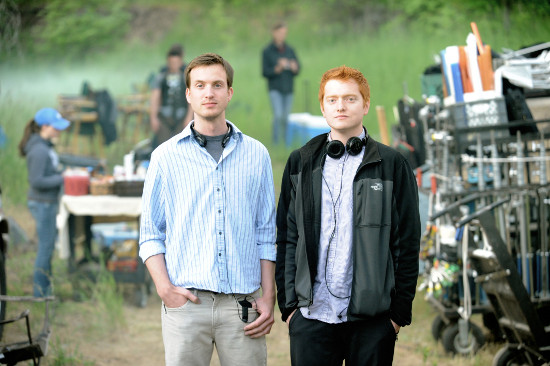
The train rumbles toward you, and then it's over you, throwing sparks. It's a short train, but it's nonetheless a harrowing seven seconds - looking, sounding, and feeling uncomfortably real.
That's because, on a practical level, it is real.
This happens less than 10 minutes into the new, nationally distributed horror movie Nightlight by writers/directors Scott Beck and Bryan Woods, the filmmaking duo from the Quad Cities now based in Los Angeles.
"That whole sequence was a lot of fun to figure out," Beck said in a recent phone interview. The special-effects team proposed using computer animation for the train, he said, but he and Woods asked: "Could we actually get a real freight train on these tracks?"
We've been introduced to five teens who've come to a supposedly haunted forest for "flashlight games." One involves laying down a flashlight on railroad ties, running down the tracks to a specific point, and then running back and grabbing the flashlight. There's not much to it ... except for the train.
This bit lasts roughly a minute and 40 seconds, done in a single shot.
"The scene starts with the train incredibly far away, [and] it just gets closer and closer," Woods said.
We can only hear the train's horn as the first three people complete the task - getting louder with each blast. With the fourth teen, we can see the headlight peeking through the trees as the engine comes around a bend.
And after Shelby, our protagonist, puts her flashlight on the ties, we see the train itself, with her sprinting toward it and then back toward her flashlight.
She jumps away just before the train hits her, but her flashlight - which belonged to a friend who committed suicide and provides the point of view for all the movie's action - remains on the tracks, and the audience gets an unsettling understanding of what it would feel like to be under a freight train moving at full speed.
"There's something hopefully suspenseful about being stuck on these rails," Woods said.
Quite intentionally, Beck and Woods have updated one of the wonders of early cinema: the Lumière brothers' famous 1896 film that put audiences in the path of a locomotive.
Movies, Beck said, "can be like a magic trick, and I think it's really rare to see that. And so you want to bring that original spectacle to it. ... You want to give modern-day audiences that, and it's really difficult when they're very jaded and they've seen everything. ... So the aspiration is to really challenge yourself as a filmmaker to come up with something incredibly unique. And sometimes you get it, and sometimes you don't, or sometimes you think you've got it but it doesn't really work."
It absolutely works in Nightlight, and it's not merely the result of that moment, of the visual and aural elements that put the audience underneath the train. It's the escalating tension in the single shot, as Shelby shifts from observer to participant. It's the helplessness the audience feels when it's been abandoned by Shelby on the train tracks. (In a neat trick, our anxiety is rooted less in her fate than our own.)
And it's definitely a function of Beck and Woods using an actual moving train. Despite the verisimilitude of today's computer-generated imagery, audiences know deep down the difference between pixels and metal.
"It was really fun to try to choreograph the dance of getting the timing perfect when you're using practical [rather than digital] effects," Woods said. "Really trying to get all the different departments on the film to do the ballet with us was so much fun, but also very terrifying, because every day on set we're like, 'Is this going to be a disaster? Are we going to be able to pull this off?' It was very intimidating."
"The challenge was making sure it was safe," Beck said, "but also making sure it felt like the train was close enough to the stunt performer to make it feel real."
And given that beyond the train stunt, the POV flashlight (and the equipment used to mimic it) goes underwater and over a cliff, it's somewhat miraculous that no camera met its demise during the making of Nightlight.
"For a moment there, we thought were going to blow $100,000 on our expensive camera being run over by a train," Beck said. "You would think more things would have been destroyed. Our insurance [carrier] was very happy with us."

"Waiting Waiting Waiting"
From 2002 to 2006 - while they were students at Bettendorf High School and then the University of Iowa - Beck and Woods (separately and together) wrote, directed, and produced nine short and feature-length movies under their Bluebox Limited (now Bluebox Films) banner.
In the nine years since the release of their 60-minute contemporary Western The Bride Wore Blood, however, there's been little: the 2010 short film Impulse, and the 2012 TV pilot Spread (which MTV declined to order to series).
Beck moved to Los Angeles after college graduation in 2007, and Woods has lived there about half as long. The period since The Bride Wore Blood contains the familiar story of DIY artists trying to find a foothold in Hollywood. They worked at a movie theater. They wrote. They knocked on doors.
"We spent those years writing a ton of scripts, and writing things either for the marketplace or things that we could shoot back in Iowa," Beck said. "We probably have six or seven scripts that could result from that three-and-a-half-/four-year period."
They could have continued to do what they'd done in high school and college, Woods said: "When we wanted to make a movie, we just go out and make a movie."
But Beck said they had higher goals: "As much as we love making movies in Iowa, our aspirations were always to have a foot in the studio system. So obviously there's the benefit of living out here and just pounding down doors until something inevitably happens. It's a struggle at the same time."
"When you do it on a professional level," Woods said, "you're just waiting waiting waiting and developing and developing and developing."
"When it got to be around 2009," Beck said, "Bryan and I were just getting really frustrated by not directing anything. ... It gets really depressing after a while."
So, in a fashion, the 30-year-old filmmakers have finally made it - at roughly the same age that many prominent directors began their major-feature-film careers.
Nightlight was released March 27 by Lionsgate Entertainment - theatrically in 10 major cities, and on-demand nationwide (including iTunes, Amazon Instant Video, and DirectTV, but not Mediacom or Dish). The writing/directing duo can now say it's gotten reviews from the New York Times, the Los Angeles Times, the Hollywood Reporter, and RogerEbert.com. (You can read Mike Schulz's review here.)
Beck and Woods also have a contract to direct XOXO, which has an impressive pedigree. Its producers include Oscar nominees Darren Aronofsky (the writer/director of Pi and Requiem for a Dream and the director of The Wrestler, Black Swan, and Noah) and Michael London (producer of Sideways and Milk), and the script was written by Mark Heyman (Black Swan).
But Beck and Woods know that nothing is certain, and it's unlikely they'll want Nightlight to be the apex of their careers. The contract for XOXO doesn't mean the movie will actually get made - or that they'll end up directing it if it does. And while they do now have those reviews from prestigious institutions, they're not the sort one wants to frame and put on the wall - except, perhaps, as motivational tools.
"Every project we take on is just like fighting fighting fighting hustling hustling hustling," Woods said. "It's pretty nonstop. Even right now, we have five or six projects going, and you never know what's going to pop. You try to juggle as many projects as you can at the same time because it's just a fight."
"It feels ... everyday that we could lose everything tomorrow," Beck said.
Still, he added, they appreciate the victories - the day Lionsgate picked up Nightlight, the day they were selected to direct XOXO: "We definitely try to drink in those moments."
"They are few and far between," Woods said, "because most of our job is just sheer rejection."
But although Nightlight clearly represents a success, before the movie's release Woods said that "we're certainly super-nervous about it, because we've never had a work of ours exposed to that many people at once, so we're kind of shielding ourselves over here ... . We hope it finds an audience that will appreciate it and enjoy that we took some risks and experimented with the form."
"The Audience Is Going to Fall Off a Cliff"
 That experimentation isn't evident in the broad strokes of Nightlight. Five young people in woods that have a dark history, the handheld camera ... . In 1999, The Blair Witch Project proved the commercial viability of this relatively inexpensive style of horror movie, and "found footage" has become ubiquitous - and synonymous with cheap and lazy filmmaking.
That experimentation isn't evident in the broad strokes of Nightlight. Five young people in woods that have a dark history, the handheld camera ... . In 1999, The Blair Witch Project proved the commercial viability of this relatively inexpensive style of horror movie, and "found footage" has become ubiquitous - and synonymous with cheap and lazy filmmaking.
But Beck and Woods weren't lazy with Nightlight. Their inspirations and aspirations were actually pretty damned highfalutin: They wanted to reinvigorate the found-footage style of horror movie and take advantage of some of its natural formal characteristics - in particular lengthy shots and a rigid point of view.
The idea, Woods said, "came from an appetite for the found-footage subgenre - like Blair Witch Project, Paranormal Activity - but also feeling a bit of a fatigue with those movies. As much as we enjoyed them, and as fun and scary as they were to see in theaters with big audiences, it also started to feel ... a little tired. We wanted to try to find a new window into a genre that we loved."
So they had the idea of using the point of view of one character's flashlight instead of a video camera (or video cameras) held by characters - which had the immense benefit of avoiding that pesky narrative problem of characters shooting footage while being chased by monsters or soiling themselves in fear.
"It really came from our childhood - just playing flashlight games in the woods," Beck said. "As filmmakers, ... we wanted to tap into the fear that we felt when doing that ... : You're all alone in the woods with only a beam of light. ... I think it's just an incredibly immersive experience for the audience."
"The promise of the premise is the audience has to go where the flashlight goes," Woods said. "If the flashlight falls off a cliff, the audience is going to fall off a cliff. If the flashlight falls in a creek, we're going to go down a creek. You're kind of stuck with it."
There was also the appeal of the function of flashlights, he continued - which is also a metaphor for what horror movies do: "What they do is look into the dark. ... And to force the audience to look into the dark and look into the shadows at something they might not want to see, we were just kind of hoping that would be a scary experience."
Beck added that shooting in widescreen meant that the flashlight's circle of illumination was surrounded by darkness: "It was a great inherent visual opportunity to have the audience looking off into the periphery and wonder what might be out there. ... It was fun to play with the balance of darkness and light from this perspective."
Throughout Nightlight, Beck and Woods are tremendously playful - in their cruelly suspenseful way of keeping characters off-screen for long periods of time, and especially in messing with audience assumptions of who (or what) is holding the flashlight at any given moment.
And they throw so much into the stew - monsters, wild animals, ghosts, possession - that the movie might best be appreciated as a poker-faced parody of found-footage scare flicks.
But lest you think Beck and Woods are merely horror junkies, they were the ones who mentioned the Lumières - along with some more-contemporary heroes.
Woods said Nightlight drew significantly from Gus Van Sant's "Death Trilogy": Gerry, Elephant, and Last Days. "He just kind of follows these characters with these long tracking shots," he said, and he and Beck thought "it would be interesting to appropriate that style into the horror genre. To be able to follow characters around for extended periods of time ... could be really suspenseful in a horror context." (Ironically, Van Sant has finished the drama The Sea of Trees, which takes place in Japan's Suicide Forest - one inspiration for Nightlight.)
Beck and Woods also wanted to make a movie that looked better than its peers.
"This film in general is very odd for us," Beck said. "This ... was much more a documentary approach. But we still wanted to make sure there was something visually aesthetic to it. That's our sensibility."
"Found footage you associate with a low-budget, kind of ugly-looking movie," Woods said. "While I do not think we achieved this at all, our mantra was always like: 'What if Stanley Kubrick made a found-footage movie? What would it look like? What would a high-end version look like?' That was what we were aspiring to. ... We wanted to do something that had an aesthetic prettiness to it as well as be terrifying."
Woods was laughing as he was saying this, because while one can clearly see an eye for strong compositions in much of the duo's other work, there really aren't many opportunities for that when the movie is shot from the point of view of a flashlight. "I think what we realized by the end of the movie," he said, "was [that] Stanley Kubrick would just never make a found-footage movie."
If the style didn't quite fit with Beck's and Woods' natural tendencies - or their Kubrick-ian ideal - the long takes, at least, aligned with their vision. "I think we just know as viewers what we respond to, and certainly we respond to movies like Children of Men," Woods said. "We love to see directors using every tool of cinema that they have at their disposal. ... There's something so ineffective about a movie that's just covered from every angle with quick cuts and your basic close-up. There's something not moving about that, for us as viewers."
"There's many ways to shoot a movie," Beck added, "but ideally you come up with the one right way to shoot it that really conveys the information as succinctly as possible."

"There's No Handbook for That"
Beck said he and Woods started outlining Nightlight in 2010 or 2011, when they were still working in a movie theater.
Those jobs, Woods said, certainly informed their writing - from a love of a collective horror-movie experience to understanding teenagers: "It's a great way to stay in touch with real life and real people. ... Having a sense of what they're interested in, how they sound when they talk, it was rocket fuel for writing."
"We were just trying to formulate the script and figure out how the hell we can get out of these minimum-wage jobs and actually make a movie," Beck said. "L.A.'s expensive, and it's not always a fun place to live when you're not actually making movies. ...
"We did write it with a couple paths of production in mind," he continued. Although he wouldn't say how much the movie cost to make, "there was also the version where it could have been done for ... $100,000, for instance, or $200,000, where it would be much more pared down and we could bring it back to Iowa and shoot it."
How they actually got the film made (with a bigger budget) illustrates the time and work that go into starting a career in the film industry. Impulse was a key to getting to the MTV pilot, and it didn't hurt that the duo had a prior relationship with MTV Films because of a 2005 development deal won in an mtvU contest.
The pilot, in turn, "was the directing sample that we took with the script for Nightlight that was able to sell us as writers/directors," Beck said.
The Nightlight script - with the directing sample Spread - landed the movie financing, with London as one of the producers.
The movie was shot for five weeks in Utah in summer 2012, and post-production took it into summer 2013 - time needed to get Nightlight into a form that made sense for the horror movie it was.
"It's very experimental," Woods said, "and there's really no rules for how to make a flashlight movie. There's no handbook for that."
So while Beck and Woods were fond of those long, Van Sant-y takes, they weren't always compatible with a genre in which 90 minutes is a typical length. There was a lot of work, in other words, getting the movie from its longest (110 minutes) to its final version (85 minutes).
"What we found was that while that [longer] version of the film was more artistically satisfying," Woods said, "it was also a bit alienating and harder to connect with characters."
"As much as it can be enticing and immersive," Beck said, "it's also immersive to the point where I don't know if it would sustain itself for two hours."
That post-production period was also important for the movie's impressive sound design, which follows through on the title sequence's visual promise of the audience effectively being inside a flashlight.
All that culminated with a distributor screening that also included a hundred non-industry audience members. (Keep in mind that finishing a movie doesn't mean that anybody will actually see the thing.) "The distributors would be watching the movie with the audience watching the movie to see how they react," Woods said. "It was super-scary, because we had no idea how the audience would react. They could have booed us off the screen. You never know. ... Luckily, the reaction was really positive."
Lionsgate bought the movie and released it unmolested. "Usually, they have issues with it, or they want to fix things with it," Beck said. "But ... they really loved the finished product. ... They slapped the Lionsgate logo on the front and on the end, and that was pretty much it."
That distributor screening underscores the importance of relationships and timing to a Hollywood career. Beck and Woods received the script for XOXO from their agents in late 2013 ("Are you sure you meant to send to us?" Beck said with a laugh. "We just fell in love with it immediately."), and they pitched their take on it to Lionsgate within a few days of the Nightlight screening. London's company was already attached to XOXO.
Beck called it "very fortuitous" that Lionsgate bought Nightlight at the same time it was selecting a director for XOXO - and that he and Woods already had a working relationship with London.
But even though they have a foot in the door in Hollywood, Beck and Woods promised that they won't just become directors for hire - or retire their Bluebox Films production company.
"Our model has and always will be that there are situations where we will come aboard as directors if it's a script that we really, really love," Beck said. "But it's so odd and so hard to find a script that connects with us. Usually that means Bryan and I want to write our own material."








